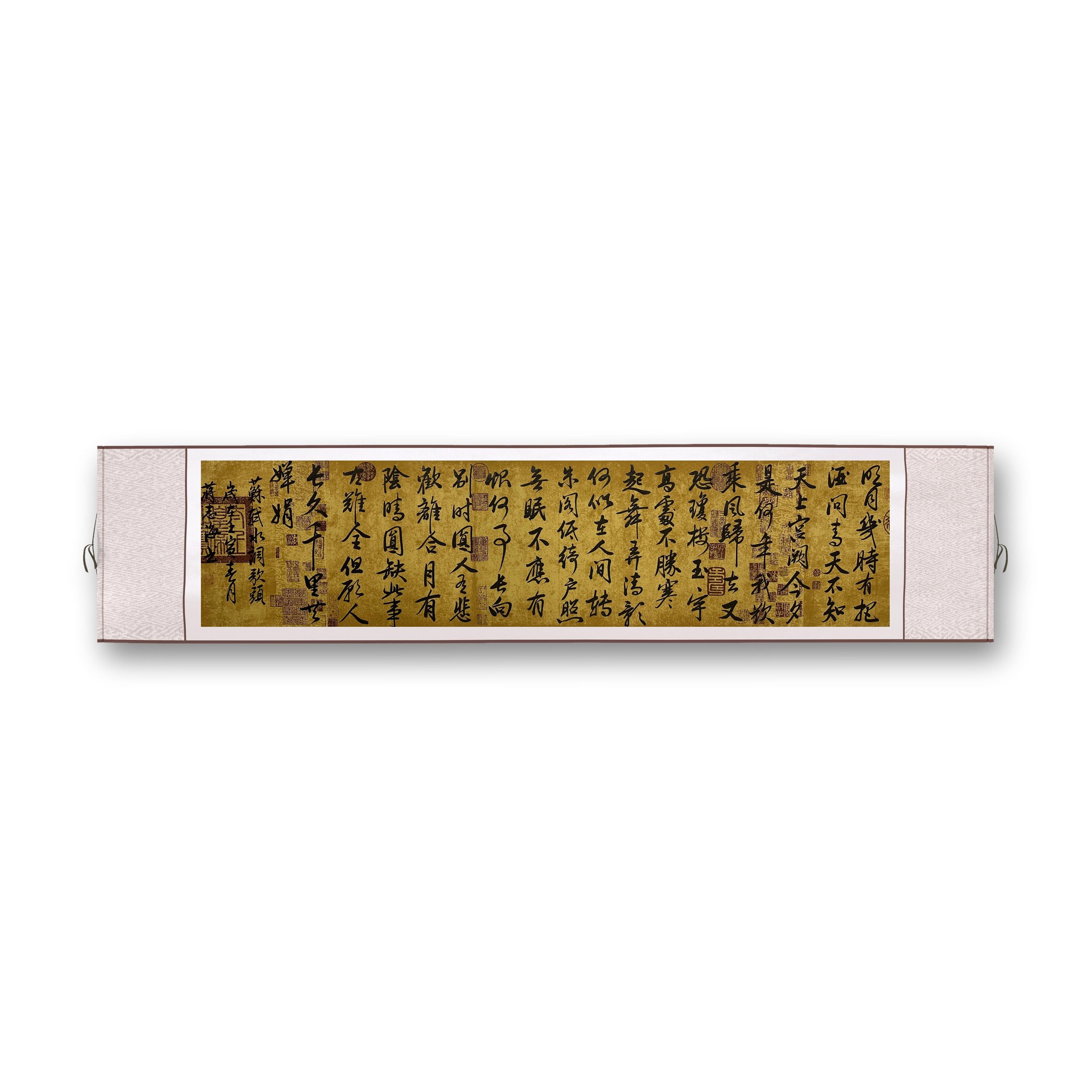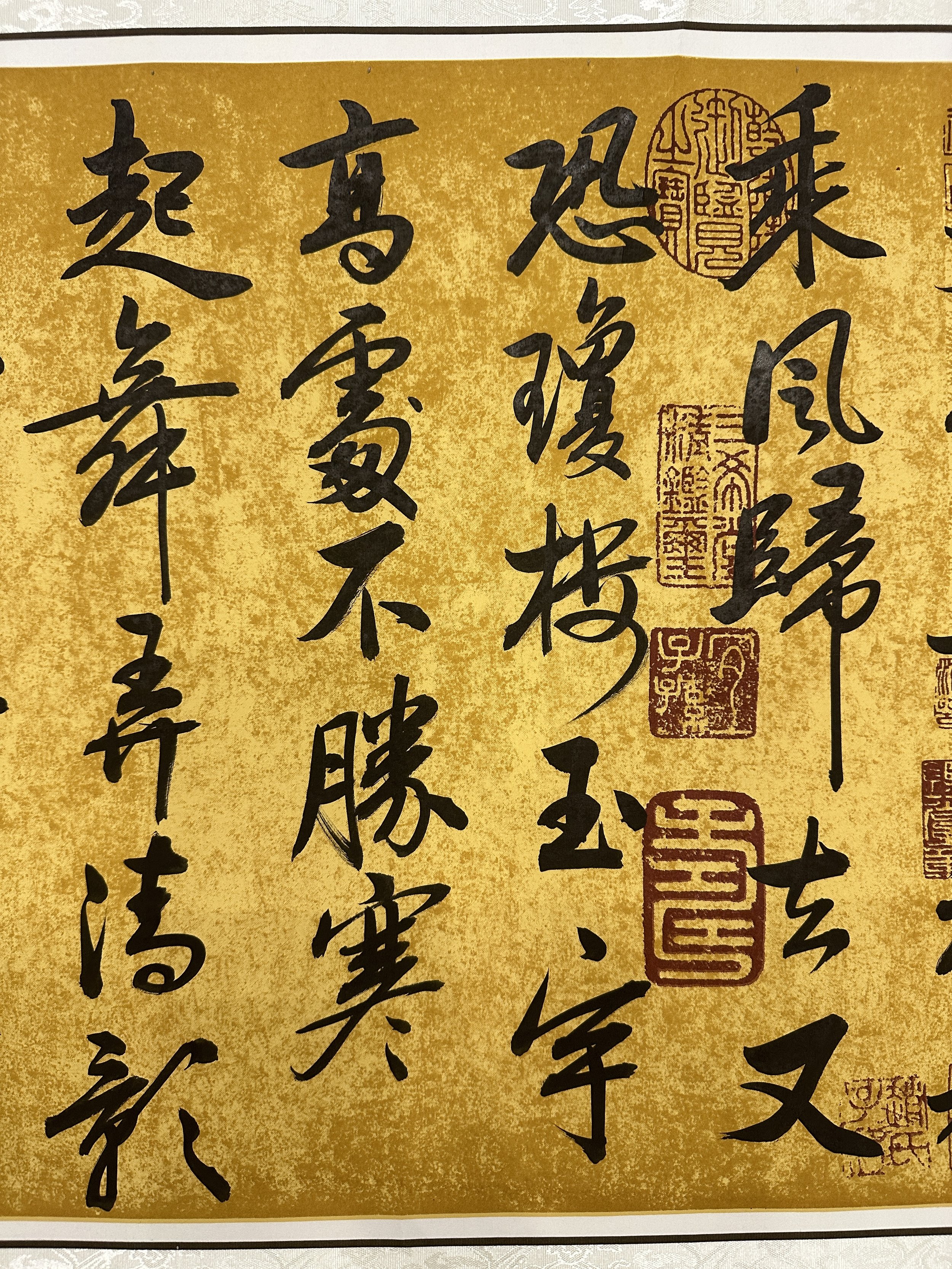 Image 1 of 7
Image 1 of 7

 Image 2 of 7
Image 2 of 7

 Image 3 of 7
Image 3 of 7

 Image 4 of 7
Image 4 of 7

 Image 5 of 7
Image 5 of 7

 Image 6 of 7
Image 6 of 7

 Image 7 of 7
Image 7 of 7








苏轼 水调歌头 Water Melody
“水调歌头” (Shui Diao Ge Tou) is one of the most famous poems by the renowned Chinese poet Su Shi (苏轼), also known as Su Dongpo (苏东坡), a prominent figure of the Song Dynasty (960–1279). The poem is celebrated for its deep philosophical reflection, emotional expression, and mastery of the regulated verse style. It was written in ci form, a type of Chinese lyrical poetry that uses fixed patterns of rhyme and rhythm.
Background:
Su Shi wrote “水调歌头” in 1076 while he was living in exile in the city of Huangzhou. The poem was inspired by a moonlit night, and it was particularly written on the occasion of the Mid-Autumn Festival. The poem reflects both personal emotions and broader philosophical themes, touching on themes of separation, longing, and the cyclical nature of life, while also addressing the poet’s longing to be reunited with his brother, Su Zhi, who was living far away.
Famous Excerpt:
The most famous part of the poem is the opening line, often quoted for its emotional depth:
“明月几时有?把酒问青天。”
(Míng yuè jǐ shí yǒu? Bǎ jiǔ wèn qīng tiān.)
(When will the bright moon appear? I raise my wine to ask the clear sky.)
In this line, the poet asks when the moon will appear, symbolizing his deep feelings of longing and the passage of time. The moon becomes a metaphor for unattainable desires and distant loved ones.
Themes:
1. Longing and Separation: Su Shi expresses his yearning for his brother and his distant home. The moon, which he gazes at, becomes a symbol of both his personal longing and a universal longing for reunification.
2. Philosophical Reflection: The poem moves from personal yearning to philosophical contemplation on life’s impermanence, the passage of time, and the nature of human existence. The poet muses on the fleeting nature of life and the cyclical relationship between the moon and human experience.
3. Unity with Nature: Like many poets of his time, Su Shi reflects on the unity of man and nature, contemplating how the moon continues to shine down on people in different places, emphasizing that despite distances, human emotions are universal.
Translation of the First Few Lines:
“The bright moon, when will it appear?
I raise my wine to ask the clear sky.
I don’t know what year it will be,
But we meet each other in the endless sky.”
Influence:
“水调歌头” has left a profound impact on Chinese literature and culture. It is frequently recited, adapted, and referenced in various forms of Chinese art. Its reflective tone, lyrical beauty, and philosophical depth make it one of the quintessential examples of Song Dynasty poetry and one of Su Shi’s most enduring works.
“水调歌头” (Shui Diao Ge Tou) is one of the most famous poems by the renowned Chinese poet Su Shi (苏轼), also known as Su Dongpo (苏东坡), a prominent figure of the Song Dynasty (960–1279). The poem is celebrated for its deep philosophical reflection, emotional expression, and mastery of the regulated verse style. It was written in ci form, a type of Chinese lyrical poetry that uses fixed patterns of rhyme and rhythm.
Background:
Su Shi wrote “水调歌头” in 1076 while he was living in exile in the city of Huangzhou. The poem was inspired by a moonlit night, and it was particularly written on the occasion of the Mid-Autumn Festival. The poem reflects both personal emotions and broader philosophical themes, touching on themes of separation, longing, and the cyclical nature of life, while also addressing the poet’s longing to be reunited with his brother, Su Zhi, who was living far away.
Famous Excerpt:
The most famous part of the poem is the opening line, often quoted for its emotional depth:
“明月几时有?把酒问青天。”
(Míng yuè jǐ shí yǒu? Bǎ jiǔ wèn qīng tiān.)
(When will the bright moon appear? I raise my wine to ask the clear sky.)
In this line, the poet asks when the moon will appear, symbolizing his deep feelings of longing and the passage of time. The moon becomes a metaphor for unattainable desires and distant loved ones.
Themes:
1. Longing and Separation: Su Shi expresses his yearning for his brother and his distant home. The moon, which he gazes at, becomes a symbol of both his personal longing and a universal longing for reunification.
2. Philosophical Reflection: The poem moves from personal yearning to philosophical contemplation on life’s impermanence, the passage of time, and the nature of human existence. The poet muses on the fleeting nature of life and the cyclical relationship between the moon and human experience.
3. Unity with Nature: Like many poets of his time, Su Shi reflects on the unity of man and nature, contemplating how the moon continues to shine down on people in different places, emphasizing that despite distances, human emotions are universal.
Translation of the First Few Lines:
“The bright moon, when will it appear?
I raise my wine to ask the clear sky.
I don’t know what year it will be,
But we meet each other in the endless sky.”
Influence:
“水调歌头” has left a profound impact on Chinese literature and culture. It is frequently recited, adapted, and referenced in various forms of Chinese art. Its reflective tone, lyrical beauty, and philosophical depth make it one of the quintessential examples of Song Dynasty poetry and one of Su Shi’s most enduring works.
Return & Exchange Policy
At Momoon Art, each painting is a one-of-a-kind creation. As such, we do not accept returns or exchanges unless the item arrives damaged during the delivery process.
If your artwork is damaged upon arrival, please contact us within [7 days] of receiving your order. We will gladly offer a refund or exchange once the damage is verified.
Thank you for understanding and supporting unique, handcrafted art!
